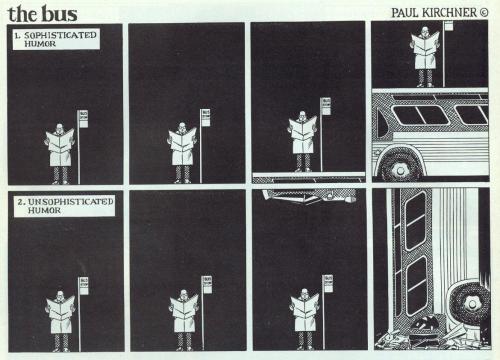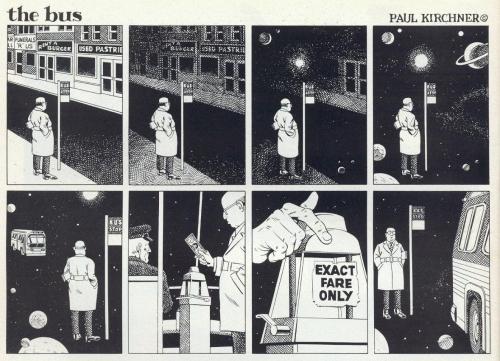giovedì, ottobre 31, 2013
lunedì, ottobre 28, 2013
Daily life: Peru by Rodrigo Abd
Daily life: Peru by Rodrigo Abd:






Today's post highlights the recent work of Associated Press photojournalist Rodrigo Abd's in Peru. His subjects include members of the Ashaninka tribe; the Lord of Huanca Sanctuary; the "Ojo que Llora" memorial; blinding mists called "la garua"; and a memorial service for the Bishop Emeritus of Huancavelica. Abd was part of the 2013 Pulitzer Prize winning entry for breaking news by the AP for its coverage of the Syrian civil war. -- Lloyd Young ( 58 photos )

Ashaninka Indian girls play soccer on Sept. 30 in Kitamaronkani, Pichari district, Peru. The Ashaninka Indian world has rarely been peaceful. Peruís Ashaninka Indians share the world's top coca-growing valley with drug traffickers, rebels, illegal loggers and, now, an increased military presence. During Peruís 1980-2000 internal conflict, Shining Path rebels overran their lands and slaughtered them wholesale. (Rodrigo Abd/Associated Press)
venerdì, ottobre 25, 2013
Visualizing the Human »
Visualizing the Human »:
 It is no vice that we can hold things to be true that, nonetheless, we are unable to visualize. Mathematicians do it every day when they work with imaginary numbers (which, contrary to their name, cannot be imagined). Particle physicists likewise write equations that express the truth about matter, a truth that is deeply paradoxical and thus unimaginable. And theologians, such as yours truly, speak of God as creating us while realizing that there can be no picture of creation : You can show a movie of some lumber being elegantly shaped into a chair, but you cannot show a movie of something being given existence. To create is not to reshape already-existing stuff but rather to let stuff be. There is no imagining Let there be light."
It is no vice that we can hold things to be true that, nonetheless, we are unable to visualize. Mathematicians do it every day when they work with imaginary numbers (which, contrary to their name, cannot be imagined). Particle physicists likewise write equations that express the truth about matter, a truth that is deeply paradoxical and thus unimaginable. And theologians, such as yours truly, speak of God as creating us while realizing that there can be no picture of creation : You can show a movie of some lumber being elegantly shaped into a chair, but you cannot show a movie of something being given existence. To create is not to reshape already-existing stuff but rather to let stuff be. There is no imagining Let there be light."
It used to be this way with regard to the mystery of the life of a child before birth. There were signs that something was going on inside the mother: Her body changed in many ways, and in due course her belly visibly swelled and kicking could be felt. People knew, as an intellectual matter, that there was a child inside her womb. But it was nigh impossible to visualize that child. It was no vice, indeed it was a virtue, to affirm the humanity of that which resided in the womb. Nonetheless, the childs human reality remained, in a sense, hypothetical because not seen.
I think back half a century now to my mothers swollen belly. I was about six years old, and I was allowed to feel it, and feel through it some particular bumps. The babys kicking you," I was told. I also remember the day when my mother was in dreadful pain and taken away. There was blood on her mattress. And I remember sitting in the funeral homes car at the cemetery, and lovely people smiling at me as they walked by my window. Over the years our family would visit the grave on occasion, usually to pull weeds and clip the grass. The stone says Marsha Jeane Austin," and it has a single date on it.
That I had had a sister, and that she was stillborn, is a truth I grew up with. In my young adulthood I sometimes imagined what it would be like to have grown up with her. When I came to believe that there is communion of the dead and the living, I sometimes asked her to pray for me. But, for the most part, her human reality was more hypothetical than actual. I had, and have, never seen her.
All this is changing.
Every young expectant couple I know today, without exception, when they have a prenatal visit, hope they will get to see the baby. Every babys photo book today has a sonogram for its first picture. The first pictures, and there are often many of them, are prenatal.
And it is changing how parents talk about their child. Our little guy," one couple recently told me, hes as big as my thumb." Or: Our baby would now fit in the palm of my hand." They delight in seeing the babys limb, the head, the sex, even fingers. They delight in seeing the heart and looking into its chambers.
What is happening, largely unnoticed and far below the radar of the political debates, is that our cultures visual imagination of the human is expansively changing. We used to picture the human life cycle as going from birth to death. But adults who are now becoming parents, along with their friends and an increasingly wider circle, no longer think it strange to consider and picture as a human being, as one of us, one whose weight is measured in ounces rather than pounds and whose size is given in terms of a portion of ones own hand.
It is hard to overstress this generational change. I know a young priest who lost a child somewhere around the middle of his wifes pregnancy. This was their second child, and they named her. They would routinely speak of their two children, by name, even though only the one child was alive and growing in their family. This priest was admonished by an older colleague not to talk that way. You may think that way, he was told, but it is really strange to talk that way. People think youre weird.
The change is this: Thanks to technologys advance, it is increasingly not weird to visualize and speak of humans by name who never weighed more than a pound. Or half a pound. Or less.
I did not speak or even much think of my stillborn sister, even though she was pretty much full term. But today we can see with our eyes and thus have the boldness to speak with our lips what we previously knew but couldnt visualize: that some of our brothers and sisters would easily have fit in the palm of even a very small hand.
Victor Lee Austin is author of Up with Authority and Christian Ethics: A Guide for the Perplexed. He is theologian-in-residence at St. Thomas Church in New York City.
Become a fan of First Things on Facebook , subscribe to First Things via RSS, and follow First Things on Twitter.
 It is no vice that we can hold things to be true that, nonetheless, we are unable to visualize. Mathematicians do it every day when they work with imaginary numbers (which, contrary to their name, cannot be imagined). Particle physicists likewise write equations that express the truth about matter, a truth that is deeply paradoxical and thus unimaginable. And theologians, such as yours truly, speak of God as creating us while realizing that there can be no picture of creation : You can show a movie of some lumber being elegantly shaped into a chair, but you cannot show a movie of something being given existence. To create is not to reshape already-existing stuff but rather to let stuff be. There is no imagining Let there be light."
It is no vice that we can hold things to be true that, nonetheless, we are unable to visualize. Mathematicians do it every day when they work with imaginary numbers (which, contrary to their name, cannot be imagined). Particle physicists likewise write equations that express the truth about matter, a truth that is deeply paradoxical and thus unimaginable. And theologians, such as yours truly, speak of God as creating us while realizing that there can be no picture of creation : You can show a movie of some lumber being elegantly shaped into a chair, but you cannot show a movie of something being given existence. To create is not to reshape already-existing stuff but rather to let stuff be. There is no imagining Let there be light." It used to be this way with regard to the mystery of the life of a child before birth. There were signs that something was going on inside the mother: Her body changed in many ways, and in due course her belly visibly swelled and kicking could be felt. People knew, as an intellectual matter, that there was a child inside her womb. But it was nigh impossible to visualize that child. It was no vice, indeed it was a virtue, to affirm the humanity of that which resided in the womb. Nonetheless, the childs human reality remained, in a sense, hypothetical because not seen.
I think back half a century now to my mothers swollen belly. I was about six years old, and I was allowed to feel it, and feel through it some particular bumps. The babys kicking you," I was told. I also remember the day when my mother was in dreadful pain and taken away. There was blood on her mattress. And I remember sitting in the funeral homes car at the cemetery, and lovely people smiling at me as they walked by my window. Over the years our family would visit the grave on occasion, usually to pull weeds and clip the grass. The stone says Marsha Jeane Austin," and it has a single date on it.
That I had had a sister, and that she was stillborn, is a truth I grew up with. In my young adulthood I sometimes imagined what it would be like to have grown up with her. When I came to believe that there is communion of the dead and the living, I sometimes asked her to pray for me. But, for the most part, her human reality was more hypothetical than actual. I had, and have, never seen her.
All this is changing.
Every young expectant couple I know today, without exception, when they have a prenatal visit, hope they will get to see the baby. Every babys photo book today has a sonogram for its first picture. The first pictures, and there are often many of them, are prenatal.
And it is changing how parents talk about their child. Our little guy," one couple recently told me, hes as big as my thumb." Or: Our baby would now fit in the palm of my hand." They delight in seeing the babys limb, the head, the sex, even fingers. They delight in seeing the heart and looking into its chambers.
What is happening, largely unnoticed and far below the radar of the political debates, is that our cultures visual imagination of the human is expansively changing. We used to picture the human life cycle as going from birth to death. But adults who are now becoming parents, along with their friends and an increasingly wider circle, no longer think it strange to consider and picture as a human being, as one of us, one whose weight is measured in ounces rather than pounds and whose size is given in terms of a portion of ones own hand.
It is hard to overstress this generational change. I know a young priest who lost a child somewhere around the middle of his wifes pregnancy. This was their second child, and they named her. They would routinely speak of their two children, by name, even though only the one child was alive and growing in their family. This priest was admonished by an older colleague not to talk that way. You may think that way, he was told, but it is really strange to talk that way. People think youre weird.
The change is this: Thanks to technologys advance, it is increasingly not weird to visualize and speak of humans by name who never weighed more than a pound. Or half a pound. Or less.
I did not speak or even much think of my stillborn sister, even though she was pretty much full term. But today we can see with our eyes and thus have the boldness to speak with our lips what we previously knew but couldnt visualize: that some of our brothers and sisters would easily have fit in the palm of even a very small hand.
Victor Lee Austin is author of Up with Authority and Christian Ethics: A Guide for the Perplexed. He is theologian-in-residence at St. Thomas Church in New York City.
Become a fan of First Things on Facebook , subscribe to First Things via RSS, and follow First Things on Twitter.
giovedì, ottobre 24, 2013
Strange Skyscrapers: 14 of the World’s Weirdest Towers »
Strange Skyscrapers: 14 of the World’s Weirdest Towers »: [ By Steph in Architecture & Design, Travel & Places, Urban Images. ]
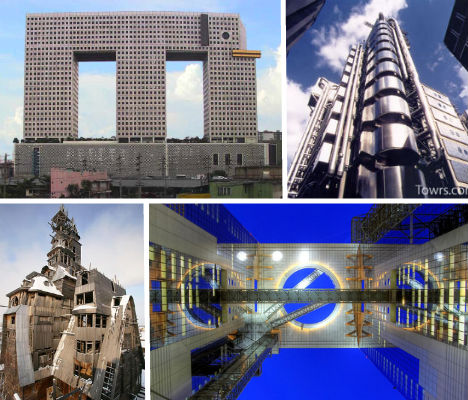
There’s the inside-out skyscraper, the horizontal skyscraper and the wooden skyscraper. There’s a bizarre three-towered structure made to vaguely resemble an elephant, tusks and all. And then there’s the giant pickle. These 14 buildings are among the most bizarre in the world, and they stand out all the more for their sheer height.
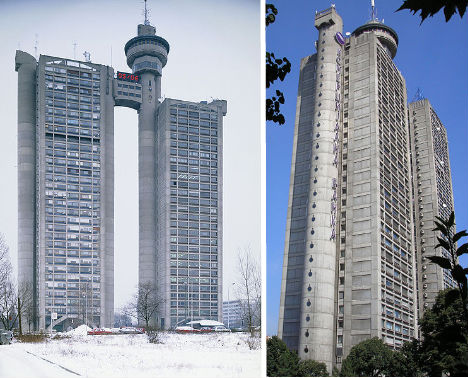
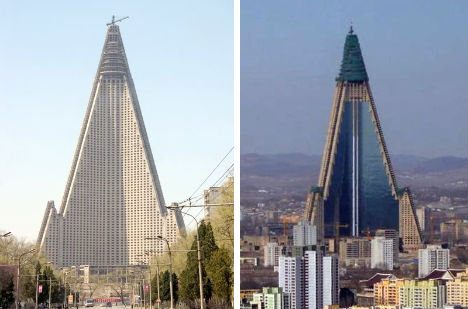
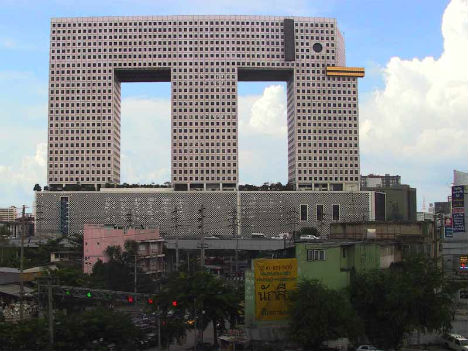
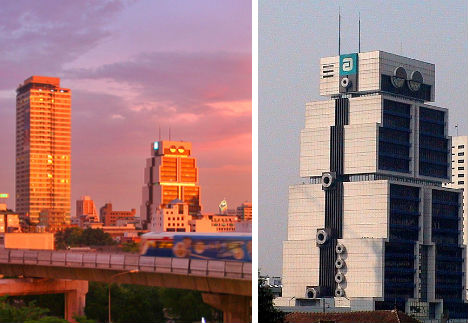
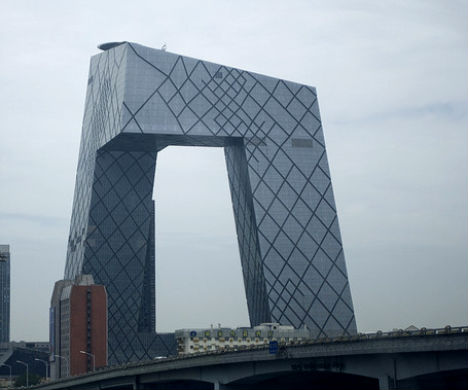
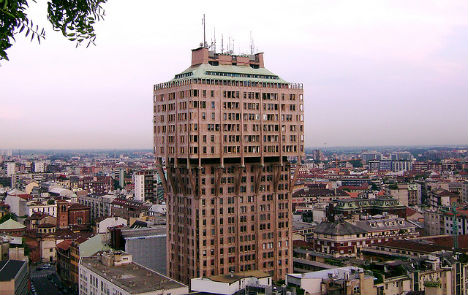
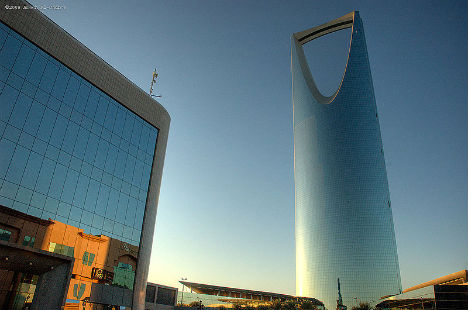


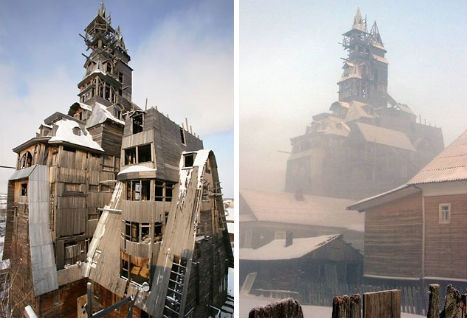
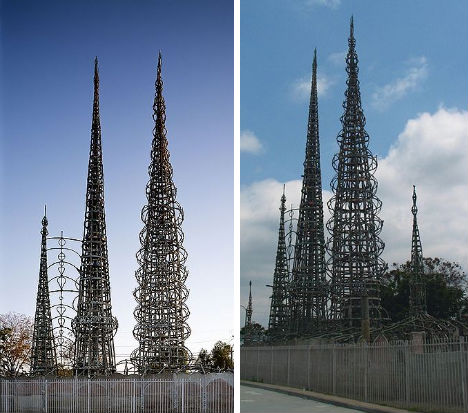
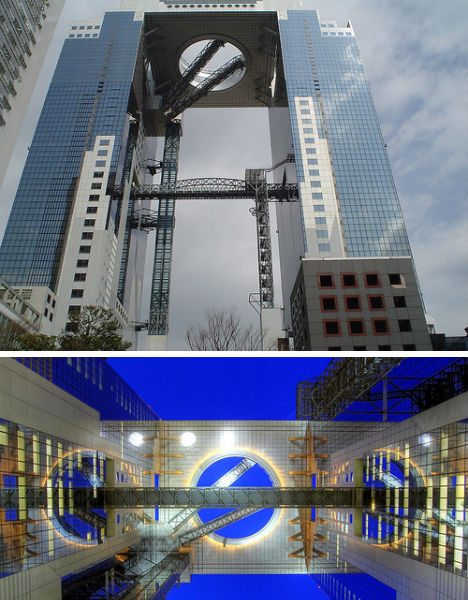
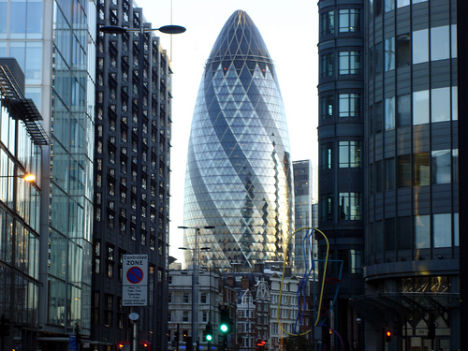
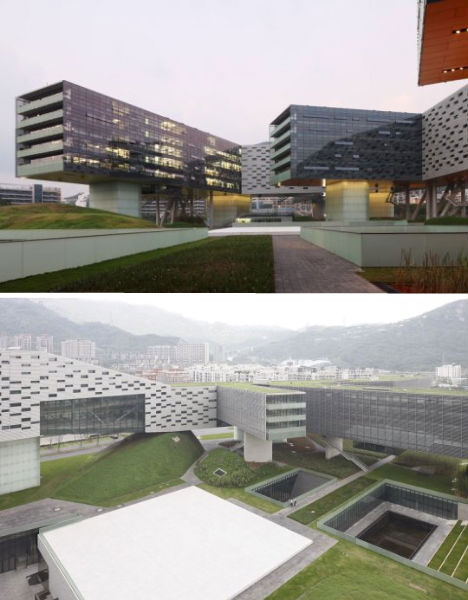

There’s the inside-out skyscraper, the horizontal skyscraper and the wooden skyscraper. There’s a bizarre three-towered structure made to vaguely resemble an elephant, tusks and all. And then there’s the giant pickle. These 14 buildings are among the most bizarre in the world, and they stand out all the more for their sheer height.
Genex Tower, Belgrade, Serbia

(image via: wikipedia)
It’s the third-largest building in Europe, designed to look like a huge gate greeting visitors as they arrive in Belgrade from the west. But Genex Tower is hardly a welcoming sight to many, called “phenomenally ugly” in more than one place on the internet and dismissed as one of the worst examples of Brutalist Architecture. The twin concrete towers, joined together by a revolving restaurant, are certainly among the stranger skyscrapers in the world.Ryugyong Hotel, Pyongyang, North Korea

(image via: wikipedia)
Is this the world’s ugliest skyscraper? Veiled in secrecy in North Korea, the Ryugyong Hotel sat in construction limbo for so long that people thought it had been abandoned. Its unusual triangular shape paired with a raw concrete finish made it a bit of a laughingstock among architecture enthusiasts, though recent changes since construction resumed have made it look a bit less severe.Elephant Building, Bangkok, Thailand

(image via: thomas riddle)
Perhaps the architects who designed this bizarre building in Bangkok stepped back from their plans and thought, hmmm, this set of three concrete blocks needs something. We know – round windows for eyes and shapes that vaguely suggest ears and tusks! Or something.Robot Building, Bangkok, Thailand

(image via: wikipedia)
When you spot this skyscraper in the Bangkok cityscape, there’s no question of what it’s supposed to be. The Robot Building was designed for the Bank of Asia to reflect the computerization of banking and is one of the last examples of modern architecture in the city. Architect Sumet Jumsai, who reportedly found inspiration in his son’s robot toy, made the building so blocky as a protest against the neoclassical and high-tech postmodern architecture that was sweeping the world in the early to mid 1980s.CCTV Headquarters, Beijing, China

(image via: buyalex)
This 44-story skyscraper, which serves as the headquarters for China Central Television in Beijing, earned the nickname “big boxer shorts” soon after completion in 2009 for its rather unusual shape. It’s described as a loop of six horizontal and vertical sections and figuring out how to translate the design into a structural reality was no easy task, especially in a seismic zone.Torre Velasca, Milan, Italy

(image via: david.orban)
Why is that tower shaped like a mushroom? Standing tall in the city center of Milan, the Torre Velasca definitely contrasts with surrounding architecture, though it was designed to be a modern interpretation of typical Italian medieval castles when it was created in 1954. It’s a divisive presence in the city, with some residents regarding it with affection and others bemoaning its dominance of the skyline.Kingdom Centre, Riyadh, Saudi Arabia

(image via: the full wiki)
With its unusual keyhole design, the Kingdom Centre in Riyadh would be a standout even if it weren’t Saudi Arabia’s tallest skyscraper and the world’s second tallest mosque. Also known as Burj Al-Mamlaka, the Kingdom Centre was selected as the world’s most well-designed skyscraper in the 2002 Emporis Skyscraper Awards. The architects created the keyhole in the top in order to conform to city laws that don’t allow occupied floors above a certain height.Lloyds Building, London, England

(image via: towrs)
The Lloyds of London building is undeniably weird between its mish-mash of architectural styles and the bizarre jumble of structures clinging to its exterior. The building, which has all of its ‘guts’ including water pipes and elevators on the outside, was ostensibly designed this way so that the interior would remain uncluttered. Whether or not this approach worked (bottom two photos) is perhaps a matter of personal opinion.Lippo Centre, Hong Kong

(image via: wikipedia)
Distinctive? Definitely. Dubbed the ‘koala tree’ for its resemblance to koalas clinging to a trunk, the Lippo Centre in Hong Kong is unlike any other office building in the world. American architect Paul Rudolph hoped to make these towers less severe with C-shaped clusters of windows that stand out in relief against the exterior.Wooden Skyscraper, Archangelsk, Russia

(images via: the telegraph, english russia)
Built by a single man out of an improbable material, Russia’s wooden skyscraper is believed to be the tallest wooden house in the world at 144 feet and 13 stories. Nikolai Sutyagin, a former gangster, spent 15 years continuously adding additional floors to his home because he was never satisfied with the way it looked. The structure is crumbling and neighbors worry about fire, but for now it’s certainly quite a sight.Simon Rodia Towers, Los Angeles, California

(images via: wikipedia)
Reaching over 99 feet into the air, the Watts Towers – also known as the Simon Rodia Towers for the Italian immigrant who spent decades building them – aren’t exactly skyscrapers. They’re more like towering sculptures. But the steel pipe, rod and wire structures are undoubtedly landmarks in the Watts district of Los Angeles and are now listed on the National Register of Historic Places.Umeda Sky Building, Osaka, Japan

(images via: aleksander dragnes, rmonty119)
Strange and futuristic, the Umeda Sky Building in Osaka features bridges and a glass-enclosed elevator that criss-cross the empty space between two towers, which are connected at the top by a rooftop observatory. The building is so tall, it provides a 360-degree view of the city.Norman Foster Gherkin, London, England

(image via: marc wathieu)
It’s been called Gherkin, Towering Innuendo and Crystal Phallus, but the unorthodox building that stands out like a sore thumb in London is officially known as 30 St Mary Axe. Designed by Norman Foster, the skyscraper was purchased for over a billion U.S. dollars, making it Britain’s most expensive office building.Vanke Center, Shenzen, China

(image via: steven holl)
Who ever heard of a horizontal skyscraper? It may sound strange, but it actually exists, and it’s one of the most iconic designs in famed architect Steven Holl’s repertoire. Also known as the Vanke Center, the horizontal skyscraper looks like a series of towers turned on their sides and suspended above a tropical landscape in Shenzen, China.lunedì, ottobre 21, 2013
venerdì, ottobre 18, 2013
Il lupo e il suo gregge »
Il lupo e il suo gregge »:

di Giovanni Guareschi
Don Camillo raccontò questa favoletta: «Un feroce lupo pieno di fame girava per la campagna e arrivò a un gran prato recinto da una altissima rete metallica. Dentro pascolavano tranquille le pecorelle. Il lupo girò tutt’attorno per vedere se qualche maglia si fosse allentata nella rete, ma non trovò buchi.
Scavò con le zampe per fare un buco nella terra e passar sotto la rete, ma ogni fatica fu vana. Tentò di saltare la siepe, ma non riusciva neppure ad arrivare a metà. Allora si presentò alla porta del recinto e gridò: “Pace! Siamo tutti creature di Dio e dobbiamo vivere secondo le sue leggi!”. Le pecorelle si appressarono e allora il lupo disse con voce ispirata: “Viva la legalità! Finisca il regno della violenza! Facciamo una tregua!”. “Bene!”, risposero le pecorelle. “Facciamo una tregua!”.
Il lupo si accucciò davanti alla porta del recinto e passava il tempo cantando. Ogni tanto si levava e andava a brucare l’erba ai piedi della rete metallica. “Uh! Guarda, guarda!”, si stupirono le pecore. “Mangia l’erba anche lui, come noi! Non ci avevano mai detto che i lupi mangiano l’erba!…”. “Io non sono un lupo!”, rispose il lupo. “Io sono una pecora come voi. Una pecora di un’altra razza”. Poi spiegò che le pecore di tutte le razze avrebbero dovuto fare causa comune. “Perché”, disse alla fine, “non fondiamo un Fronte Pecorale Democratico? Io ci sto volentieri e non pretendo nessun posto di comando. È ora che ci uniamo contro chi ci tosa, ci ruba il latte e ci manda al macello!”. “Parla bene!”, osservarono alcune pecore. “Bisogna fare causa comune!”. E aderirono al Fronte Pecorale Democratico e, un bel giorno, aprirono le porte.
Il lupo, diventato capo del piccolo gregge, cominciò, in nome dell’Idea, la epurazione di tutte le pecore antidemocratiche e le prime furono quelle che gli avevano aperto la porta. Alla fine l’opera di epurazione terminò, e quando non rimase più neppure una pecora il lupo esclamò trionfante: “Ecco finalmente il popolo tutto unito e concorde! Andiamo a democratizzare un altro gregge!”»
da “Don Camillo e il suo gregge”.



di Giovanni Guareschi
Don Camillo raccontò questa favoletta: «Un feroce lupo pieno di fame girava per la campagna e arrivò a un gran prato recinto da una altissima rete metallica. Dentro pascolavano tranquille le pecorelle. Il lupo girò tutt’attorno per vedere se qualche maglia si fosse allentata nella rete, ma non trovò buchi.
Scavò con le zampe per fare un buco nella terra e passar sotto la rete, ma ogni fatica fu vana. Tentò di saltare la siepe, ma non riusciva neppure ad arrivare a metà. Allora si presentò alla porta del recinto e gridò: “Pace! Siamo tutti creature di Dio e dobbiamo vivere secondo le sue leggi!”. Le pecorelle si appressarono e allora il lupo disse con voce ispirata: “Viva la legalità! Finisca il regno della violenza! Facciamo una tregua!”. “Bene!”, risposero le pecorelle. “Facciamo una tregua!”.
Il lupo si accucciò davanti alla porta del recinto e passava il tempo cantando. Ogni tanto si levava e andava a brucare l’erba ai piedi della rete metallica. “Uh! Guarda, guarda!”, si stupirono le pecore. “Mangia l’erba anche lui, come noi! Non ci avevano mai detto che i lupi mangiano l’erba!…”. “Io non sono un lupo!”, rispose il lupo. “Io sono una pecora come voi. Una pecora di un’altra razza”. Poi spiegò che le pecore di tutte le razze avrebbero dovuto fare causa comune. “Perché”, disse alla fine, “non fondiamo un Fronte Pecorale Democratico? Io ci sto volentieri e non pretendo nessun posto di comando. È ora che ci uniamo contro chi ci tosa, ci ruba il latte e ci manda al macello!”. “Parla bene!”, osservarono alcune pecore. “Bisogna fare causa comune!”. E aderirono al Fronte Pecorale Democratico e, un bel giorno, aprirono le porte.
Il lupo, diventato capo del piccolo gregge, cominciò, in nome dell’Idea, la epurazione di tutte le pecore antidemocratiche e le prime furono quelle che gli avevano aperto la porta. Alla fine l’opera di epurazione terminò, e quando non rimase più neppure una pecora il lupo esclamò trionfante: “Ecco finalmente il popolo tutto unito e concorde! Andiamo a democratizzare un altro gregge!”»
da “Don Camillo e il suo gregge”.
giovedì, ottobre 17, 2013
India, l’orrore della maternità surrogata »
India, l’orrore della maternità surrogata »:
Se fosse un film sarebbe una pellicola horror, da seconda serata; di quelle storie cupe, che iniziano male e, il più delle volte, finiscono peggio. Purtroppo però il dramma dell’utero in affitto, in India, non è un film bensì una realtà drammatica e redditizia, molto redditizia: si stima che, complice l’assenza di un quadro giuridico che lo regolamenti, il mercato complessivo – che si sostanzia nella disponibilità di donne che, seguite in apposite strutture, concepiscono tramite fecondazione extracorporea, portano in grembo e poi danno alla luce un figlio da cedere alla nascita – oggi abbia già sforato il tetto stellare dei 2 miliardi di dollari [1]. Una montagna di denaro che forse è la vera ragione per la quale, finora, in pochi si sono preoccupati di verificare in che cosa realmente consista questo businness. Ma in questi giorni è uscito un documento che fa finalmente chiarezza.
Si tratta di un dossier intitolato Surrogate Motherhood-Ethical or Commercial?[2] - approvato dal ministero e che reca in calce la firma della dottoressa Ranjana Kumari del Centre for Social Research – redatto in seguito ad una ricerca condotta nelle cliniche indiane dove si effettua la maternita surrogata. Il lavoro, eseguito studiando i casi concreti e intervistando 100 madri surrogate e 50 genitori committenti, pur non avendo la valenza di pubblicazione scientifica rappresenta un’inchiesta estremamente interessante perché, per la prima volta, mette a nudo la realtà di un mercato eticamente molto discutibile ma, almeno fino ad oggi, poco esplorato nelle sue dinamiche concrete. Come già accennato, gli esiti di questa ricerca sono a dir poco allarmanti e dicono, tanto per cominciare, che la maggior parte delle madri a disposizione delle cliniche che offrono il servizio di materntià surrogata non possiedono copia di quello che, per così dire, è il loro “contratto di lavoro”.
Già qui, un primo allarme. Ma è solo l’inizio: le pagine del rapporto – specificando che a queste donne, di solito, non viene devoluto più del 2% dei reali guadagni delle strutture che seguono la procedura di maternità surrogata – spiegano che non è infrequente che, nel corso della gravidanza, il bambino “commissionato” evidenzi anomalie o malformazioni fetali (cosa peraltro non rara quando si ricorre alla fecondazione extracorporea [3]) oppure, semplicemente, non corrisponda al sesso inizialmente richiesto dal committente, che può essere indiano come straniero. In quel caso, la prassi seguita dalle cliniche consiste nell’interruzione della gravidanza, ossia nel ricorso all’aborto procurato per via chimica senza il consenso e spesso neppure senza avvertire la gestante che, in questo modo, perde improvvisamente il suo bambino e con lui pure la possibilità di ricevere il già minimo compenso cui avrebbe avuto diritto.
Altre volte poi succede che i genitori committenti, vedendo il bambino dopo il parto, ne restino delusi: in quel caso alla madre surrogata, manco a dirlo, non va più della metà della retribuzione inizialmente pattuita – oltre al danno, la beffa -, mentre è assai incerto il destino del neonato dato che, dinnanzi ad uno scarso gradimento, appena il 26% dei committenti, in quel di Mumbai, sceglie di prendere comunque con sé il piccolo, mentre pare che a Nuova Delhi la percentuale cali fino addirittura al 6%. E degli altri nati “non graditi”, che ne è? Non è chiaro. C’è poi da dire che, nel corso della gravidanza, al fine di evitare l’imbarazzo per non dire la stigmatizzazione sociale riservata a quante vengono individuate quali madri surrogate, queste donne soggiornano in apposite “case rifugio”: in pratica, una sorta di prigionia obbligata lunga nove mesi.
Ad aggiungere ulteriore tragicità al tutto, non mancano inoltre casi di genitori che ricorrono all’utero in affitto – nel rapporto si cita in particolare un caso scandaloso scoperto all’aeroporto internazionale di Bombay – esclusivamente per corrispondere alla necessità di effettuare un trapianto di organi per i loro figli malati. Questo significa che a delle donne viene chiesto di diventare madri per poi procedere subito con l’eliminazione “funzionale” dei loro figli: in pratica, un infanticidio programmato o, come forse direbbe qualcuno, un infanticidio terapeutico. Come se non bastasse, leggendo Surrogate Motherhood-Ethical or Commercial? si avverte con costanza un’inquietudine: quella di chi osserva la sola punta di un iceberg; quella di chi, per la prima volta, si affaccia su scenari da veri e propri film dell’orrore ma purtroppo reali. Maledettamente reali. Scenari che dovrebbero indignare gli attivisti dei diritti umani di tutto il pianeta, a partire dalle sempre vigili femministe; e che invece giacciono dimenticati o sepolti nel web, cuore virtuale di un mondo che ne ha uno sempre più piccolo.
Note: [1] Cfr. Dhawan H. Unregulated surrogacy industry worth over $2bn thrives without legal framework. «Timesofindia.indiatimes.com», 18/7/2013; [2] Cfr. Kumari R. (2013) Surrogate Motherhood-Ethical or Commercial ? «Centre for Social Research» (CSR); 1-168; [3] Cfr. Davies M.J – Moore V.M. – Willson K.J. – Van Essen P. – Priest K. – Scott H.- Haan E.A. M.B. – Chan A. (2012)Reproductive Technologies and the Risk of Birth Defects. «The New England Journal of Medicine»; 366:1803-1813
lunedì, ottobre 14, 2013
sabato, ottobre 12, 2013
La vispa Michela [La giornata]
La vispa Michela [La giornata]:
 L’una ha scritto “Volevo essere una farfalla”, l’altra voleva acciuffare gentil farfalletta; per il resto, non si notano differenze apprezzabili tra Michela Marzano e la Vispa Teresa. E chi si accanirebbe contro la Vispa Teresa? Non stilleremo una sola goccia di sarcasmo sull’ultimo libro della filosofa e deputata, “L’amore è tutto: è tutto ciò che so dell’amore”, che Utet pubblica in questi giorni. Ma un innocente gioco di contrappunto questo sì, sarà istruttivo per illuminare un meccanismo che va ben al di là del libro e della sua autrice.
L’una ha scritto “Volevo essere una farfalla”, l’altra voleva acciuffare gentil farfalletta; per il resto, non si notano differenze apprezzabili tra Michela Marzano e la Vispa Teresa. E chi si accanirebbe contro la Vispa Teresa? Non stilleremo una sola goccia di sarcasmo sull’ultimo libro della filosofa e deputata, “L’amore è tutto: è tutto ciò che so dell’amore”, che Utet pubblica in questi giorni. Ma un innocente gioco di contrappunto questo sì, sarà istruttivo per illuminare un meccanismo che va ben al di là del libro e della sua autrice.
Continua sul sito del Foglio.it

 L’una ha scritto “Volevo essere una farfalla”, l’altra voleva acciuffare gentil farfalletta; per il resto, non si notano differenze apprezzabili tra Michela Marzano e la Vispa Teresa. E chi si accanirebbe contro la Vispa Teresa? Non stilleremo una sola goccia di sarcasmo sull’ultimo libro della filosofa e deputata, “L’amore è tutto: è tutto ciò che so dell’amore”, che Utet pubblica in questi giorni. Ma un innocente gioco di contrappunto questo sì, sarà istruttivo per illuminare un meccanismo che va ben al di là del libro e della sua autrice.
L’una ha scritto “Volevo essere una farfalla”, l’altra voleva acciuffare gentil farfalletta; per il resto, non si notano differenze apprezzabili tra Michela Marzano e la Vispa Teresa. E chi si accanirebbe contro la Vispa Teresa? Non stilleremo una sola goccia di sarcasmo sull’ultimo libro della filosofa e deputata, “L’amore è tutto: è tutto ciò che so dell’amore”, che Utet pubblica in questi giorni. Ma un innocente gioco di contrappunto questo sì, sarà istruttivo per illuminare un meccanismo che va ben al di là del libro e della sua autrice.Continua sul sito del Foglio.it
giovedì, ottobre 10, 2013
Chomsky contro i postmoderni [La giornata]
Chomsky contro i postmoderni [La giornata]:
 Non capita tutti i giorni di assistere a una simile faida fra due icone della sinistra mondiale. E’ successo fra Noam Chomsky e Slavoj Zizek. O per dirla con le parole del Wall Street Journal, “Chomsky contro Elvis”. Il primo è il grande linguista del Mit, il college nel Massachusetts che ogni anno sforna cinquecento invenzioni e centosessanta brevetti. Chomsky il guru anticapitalista, il pacifista colluso di tiranni, il mandarino nemico delle élite che entrò di ruolo al Mit ad appena trent’anni, contro Zizek, il blasonato intellettuale sloveno con cattedre in America, “il gigante di Lubiana” noto così per il suo aspetto da orso ingrigito ma non per il suo peso intellettuale.
Non capita tutti i giorni di assistere a una simile faida fra due icone della sinistra mondiale. E’ successo fra Noam Chomsky e Slavoj Zizek. O per dirla con le parole del Wall Street Journal, “Chomsky contro Elvis”. Il primo è il grande linguista del Mit, il college nel Massachusetts che ogni anno sforna cinquecento invenzioni e centosessanta brevetti. Chomsky il guru anticapitalista, il pacifista colluso di tiranni, il mandarino nemico delle élite che entrò di ruolo al Mit ad appena trent’anni, contro Zizek, il blasonato intellettuale sloveno con cattedre in America, “il gigante di Lubiana” noto così per il suo aspetto da orso ingrigito ma non per il suo peso intellettuale.
Continua sul sito del Foglio.it

 Non capita tutti i giorni di assistere a una simile faida fra due icone della sinistra mondiale. E’ successo fra Noam Chomsky e Slavoj Zizek. O per dirla con le parole del Wall Street Journal, “Chomsky contro Elvis”. Il primo è il grande linguista del Mit, il college nel Massachusetts che ogni anno sforna cinquecento invenzioni e centosessanta brevetti. Chomsky il guru anticapitalista, il pacifista colluso di tiranni, il mandarino nemico delle élite che entrò di ruolo al Mit ad appena trent’anni, contro Zizek, il blasonato intellettuale sloveno con cattedre in America, “il gigante di Lubiana” noto così per il suo aspetto da orso ingrigito ma non per il suo peso intellettuale.
Non capita tutti i giorni di assistere a una simile faida fra due icone della sinistra mondiale. E’ successo fra Noam Chomsky e Slavoj Zizek. O per dirla con le parole del Wall Street Journal, “Chomsky contro Elvis”. Il primo è il grande linguista del Mit, il college nel Massachusetts che ogni anno sforna cinquecento invenzioni e centosessanta brevetti. Chomsky il guru anticapitalista, il pacifista colluso di tiranni, il mandarino nemico delle élite che entrò di ruolo al Mit ad appena trent’anni, contro Zizek, il blasonato intellettuale sloveno con cattedre in America, “il gigante di Lubiana” noto così per il suo aspetto da orso ingrigito ma non per il suo peso intellettuale.Continua sul sito del Foglio.it
lunedì, ottobre 07, 2013
venerdì, ottobre 04, 2013
Campagna per l'iscrizione festosissima alla Società Chestertoniana Italiana!
Campagna per l'iscrizione festosissima alla Società Chestertoniana Italiana!:
Cari Amici,
vorremmo che tutti voi che frequentate questo blog diventaste soci della Società Chestertoniana Italiana, quella "vera", fatta di ciccia!
Perché?
Perché abbiamo sempre detto una cosa scherzosa ma fino ad un certo punto: iscriversi significa essere considerati davvero ed ufficialmente gli amici di Gilbert.
Significa sostenere un lavoro costante che dura da oltre dieci anni (undici per la precisione), fatto di ricerca di nuove opere da pubblicare, di aiuto agli editori ed ai traduttori, sostegno nella ricerca su Chesterton (tesi di laurea, ricerche...), di conferenze, convegni, mostre, il fantastico pirotecnico ultradecennale Chesterton Day (!), l'aggiornamento pressoché quotidiano del nostro bellissimo blog ricco di tutte le informazioni sul Nostro Gilbert (e vi assicuriamo che non ha pari! Basta cercare!), la redazione della Chesterton Review in edizione italiana, la fervida collaborazione con tutti i maggiori centri chestertoniani del mondo (il G. K. Chesterton Institute for Faith and Culture, la American Chesterton Society, il Center for Faith and Culture di Oxford...) ed ultimamente anche il sostegno concreto a realtà come il Sierra Leone Chesterton Center di John Kanu.
Significa anche essere buoni amici tra di noi: uno dei segni principali che Chesterton lascia sulla nostra pelle è quello dell'amicizia.
Costa solo € 15,00 all'anno e consente poi di avere degli sconti sui libri presto in vendita sul negozio online www.pumpstreet.it.
Come fare?
Scrivete a societachestertoniana@gmail.com e la Segreteria Volante vi darà tutte le indicazioni!
Poi, ed in ogni caso, essere considerati ufficialmente amici di Chesterton... non ha prezzo!
Per cui... vi aspettiamo!
Iscriviti a:
Post (Atom)






